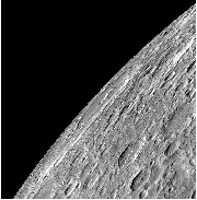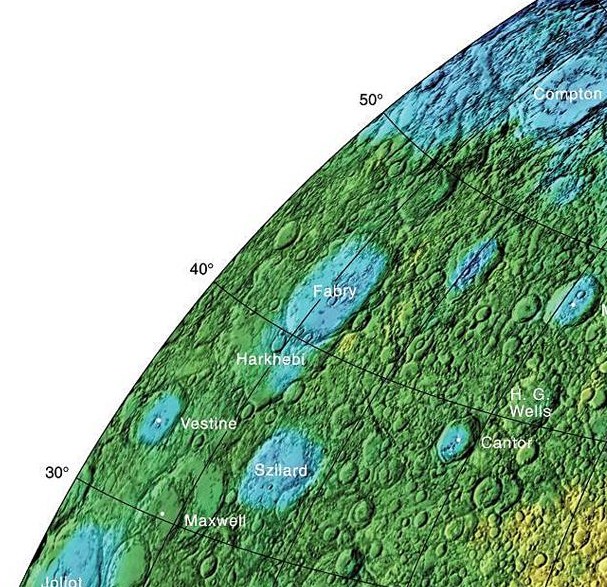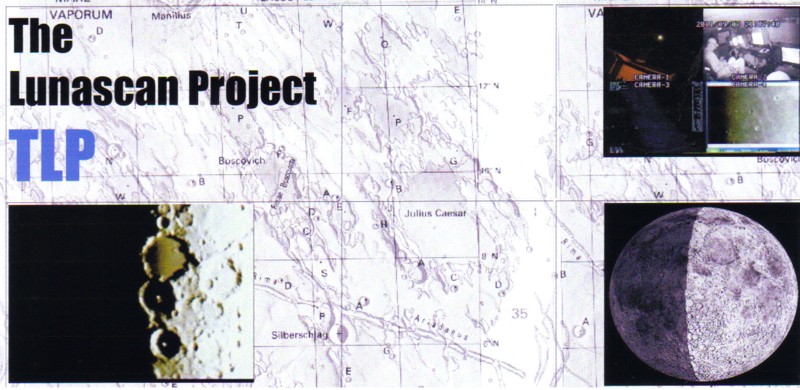|
|
presentsFABRY |
 ...
...
Left. Ridge Section 84; Right: Cropped 1200 dpi USGS color chart of Section 84
Larger version of Region
USGS Chart 4050N-100120
Lunascan Quad of Sections 084, 093 094, 096
LRO Wide Angle Camera 29 in pdf
42.9_N_100.7_E_
Ridge Section 84 is named after Fabry and contains
the famous small crater, Giordano Bruno. Fabry is a
large lunar crater (walled plain) located on the lunar Far
Side, just beyond the northeastern limb, but difficult to see
in the our cropped image above. Parts of this area are
sometimes brought into view on the Near Side by the effects of
libration, but the terrain is seen from the edge and so not
much in the way of detail can be observed. This formation is
of significant dimensions in its own right, but it overlies
the northeast rim of an even larger basin named Harkhebi. To
the west is the crater Vashalakidze, and east of Fabry is the
small crater Petrie. The best reference is the crater H.G.
Wells located on the eastern edge of our frame.
Northwards lies Swann. The outer rim of Fabry is heavily worn
and eroded, with notches from subsequent impacts. There
is a central peak formed from a long massif that covers nearly
a quarter of the crater diameter from west to east. The
remainder of the floor has been resurfaced, and now is marked
only by tiny craterlets and the rough ground along the edge of
the rim. Ray material from the young crater Giordano
Bruno to the south carries across the floor of Harkhebi, and
lies in a few faint patches on the floor of Fabry. This is
most notable in the southern part of the crater to the south
of the small crater near the midpoint.
Between Harkhebi and Szilard is the small Giordano Bruno, which is a 22 km lunar impact crater, just beyond the northeastern limb. At this location it lies in an area that can be viewed during a favorable libration, although at such times the area is viewed from the side and not much detail can be seen. When viewed from orbit, Giordano Bruno is at the center of a symmetrical ray system of ejecta that has a higher albedo than the surrounding surface. The ray material extends for over 150 kilometers and has not been significantly darkened by space erosion. Some of the ejecta appears to extend as far as the crater Boss, over 300 km to the northwest. The outer rim of the crater is especially bright, compared to its surroundings. To all appearances this is a young formation that was created in the relatively recent past, geologically speaking. The actual age is unknown, but is estimated to be less than 350 million years and was recently imaged by NASAís Lunar Reconnaissance Orbiter at an angle at a time when the setting sun cast long shadows, creating the high-relief image seen in this report. ** Itís known that the brightly-rayed crater is relatively young (see the video below) but how young? It could be anywhere from 834 years old (if some Medieval accounts are to be accepted as accurate descriptions of the craterís formation) to 2 to 4 million years old, up to even 10 million years old, of which there would obviously be no written documentation. The bright-rayed crater was named Giordano Bruno by the Russians. Bruno was a sixteenth-century Italian scientist. (Credit: Most of the information used in this section feature descriptions was obtained from wikipedia.org. Section 84 and this directory was created by Fran Ridge and Ned Haskin of The Lunascan Project).
Between Harkhebi and Szilard is the small Giordano Bruno, which is a 22 km lunar impact crater, just beyond the northeastern limb. At this location it lies in an area that can be viewed during a favorable libration, although at such times the area is viewed from the side and not much detail can be seen. When viewed from orbit, Giordano Bruno is at the center of a symmetrical ray system of ejecta that has a higher albedo than the surrounding surface. The ray material extends for over 150 kilometers and has not been significantly darkened by space erosion. Some of the ejecta appears to extend as far as the crater Boss, over 300 km to the northwest. The outer rim of the crater is especially bright, compared to its surroundings. To all appearances this is a young formation that was created in the relatively recent past, geologically speaking. The actual age is unknown, but is estimated to be less than 350 million years and was recently imaged by NASAís Lunar Reconnaissance Orbiter at an angle at a time when the setting sun cast long shadows, creating the high-relief image seen in this report. ** Itís known that the brightly-rayed crater is relatively young (see the video below) but how young? It could be anywhere from 834 years old (if some Medieval accounts are to be accepted as accurate descriptions of the craterís formation) to 2 to 4 million years old, up to even 10 million years old, of which there would obviously be no written documentation. The bright-rayed crater was named Giordano Bruno by the Russians. Bruno was a sixteenth-century Italian scientist. (Credit: Most of the information used in this section feature descriptions was obtained from wikipedia.org. Section 84 and this directory was created by Fran Ridge and Ned Haskin of The Lunascan Project).
USEFUL TOOLS:
